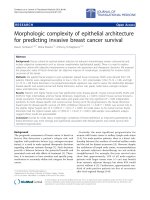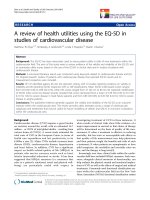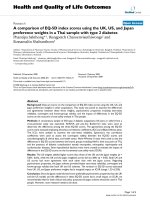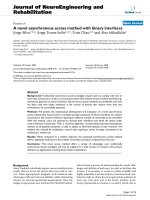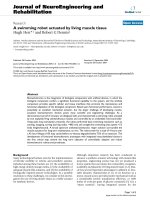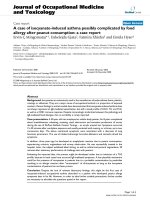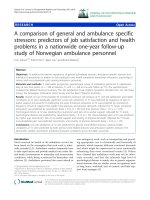báo cáo hóa học:" A framework of multi-template ensemble for fingerprint verification" doc
Bạn đang xem bản rút gọn của tài liệu. Xem và tải ngay bản đầy đủ của tài liệu tại đây (624.08 KB, 36 trang )
This Provisional PDF corresponds to the article as it appeared upon acceptance. Fully formatted
PDF and full text (HTML) versions will be made available soon.
A framework of multi-template ensemble for fingerprint verification
EURASIP Journal on Advances in Signal Processing 2012,
2012:14 doi:10.1186/1687-6180-2012-14
Yilong Yin ()
Yanbin Ning ()
Chunxiao Ren ()
Li Liu ()
ISSN 1687-6180
Article type Research
Submission date 5 July 2011
Acceptance date 19 January 2012
Publication date 19 January 2012
Article URL />This peer-reviewed article was published immediately upon acceptance. It can be downloaded,
printed and distributed freely for any purposes (see copyright notice below).
For information about publishing your research in EURASIP Journal on Advances in Signal
Processing go to
/>For information about other SpringerOpen publications go to
EURASIP Journal on Advances
in Signal Processing
© 2012 Yin et al. ; licensee Springer.
This is an open access article distributed under the terms of the Creative Commons Attribution License ( />which permits unrestricted use, distribution, and reproduction in any medium, provided the original work is properly cited.
A framework of multitemplate ensemble for fingerprint
verification
Yilong Yin
*
, Yanbin Ning, Chunxiao Ren and Li Liu
School of Computer Science and Technology, Shandong University, Jinan
250101, China
*
Corresponding author:
Email addresses:
YY:
YN:
CR:
LL:
Abstract
How to improve performance of an automatic fingerprint verification system
(AFVS) is always a big challenge in biometric verification field. Recently, it
becomes popular to improve the performance of AFVS using ensemble
learning approach to fuse related information of fingerprints. In this article,
we propose a novel framework of fingerprint verification which is based on
the multitemplate ensemble method. This framework is consisted of three
stages. In the first stage, enrollment stage, we adopt an effective template
selection method to select those fingerprints which best represent a finger,
and then, a polyhedron is created by the matching results of multiple
template fingerprints and a virtual centroid of the polyhedron is given. In the
second stage, verification stage, we measure the distance between the
centroid of the polyhedron and a query image. In the final stage, a fusion
rule is used to choose a proper distance from a distance set. The
experimental results on the FVC2004 database prove the improvement on
the effectiveness of the new framework in fingerprint verification. With a
minutiae-based matching method, the average EER of four databases in
FVC2004 drops from 10.85 to 0.88, and with a ridge-based matching
method, the average EER of these four databases also decreases from 14.58
to 2.51.
Keywords: fingerprint verification; multi-template ensemble; fusion rule;
establish polyhedron.
1. Introduction
Researchers never stop to improve the performance of a biometrics system
pursuing the lower equal-error rate (EER). Major approaches of reducing the
EER can be divided into the following two categories:
(1) Improving the performance of process steps of a biometrics system.
These steps include segmentation [1], enhancement [2], extraction [3],
matching [4], etc. However, there are some problems in this method. For
example, the room of performance increasing is limited.
(2) Fusing multiple sources of biometrics to increase the overall
performance of a biometrics system. These sources include multiple sensors,
multiple features [5], multiple matchers [6], multiple fingers [7], multiple
impressions of a same finger [8], etc. Recent research results show that the
most effective method to improve the performance of a biometrics system is
to fuse more biometric information using ensemble learning [9]. These
ensemble approaches, particularly these ensemble approaches with multiple
matching algorithms, need more computing resources and more storage.
Ensembles of multiple sensors and multiple biometric verifications also need
various kinds of sensors. Furthermore, it is very inconvenient for users since
those multiple biometric verification ensembles need to capture various
feature information from users in enrollment stage and verification stage.
Currently, multiple templates’ ensemble is widely used in biometrics
systems. In practice, multiple fingerprint images are captured and stored in
database for one finger. These fingerprint images are called multiple
templates. In current multiple templates ensemble researches, there are two
challenges: (1) how to choose the proper templates for ensemble; (2) how to
use the multiple templates information effectively.
There are a few studies have been done to deal with the problem of
template selection to solve the first challenge. Uludag et al. [10] proposed
two typical methods for automatic template selection: the first one, DEND,
employs a hierarchical clustering strategy to choose a template set that could
be best represents the intra-class variations. The second method, MDIST,
selects a template set which exhibits maximum similarity with the other
fingerprints. The MDIST achieves better performance comparing with
DEND in Uludag et al.’s study [10]. Lumini and Nanni [11] presented
another clustering method which automatically selected the number of
clusters. This method could also save memory and computational cost for a
verification task. Multiple fingerprint images of a finger are acquired in
order to obtain images of different regions of the finger [9]. So, when we
select templates, the “ideal” templates should have these advantages: (1) The
difference of these templates is big enough; (2) These templates are partially
overlapping images. “Ideal” templates are shown in Figure 1.
For the second challenge, there are two major methodologies to use
multi-template ensemble in fingerprint field: Mosaicking and Score level
fusion. With mosaic [12, 13], a larger fingerprint image could be obtained
from several small images. But, the major problem in creating a mosaicked
image is that the alignment different impressions/pieces cannot be
completely recovered. Meanwhile, with the score level fusion [9, 14, 15], a
query fingerprint has some matching scores with the templates. So, the final
score is to fuse these scores with different weights. However, these weights
are difficult to be determined in practice.
In this article, a framework of multitemplate ensemble for fingerprint
verification is proposed. As mentioned above, in the enrollment stage, some
fingerprint images are chosen and stored in database as fingerprint
templates. And then, a polyhedron is created by the matching results of
multiple template fingerprints and a virtual centroid of the polyhedron is
given. The matching scores are also stored in the database. During the
verification stage, a distance is calculated from a query fingerprint to the
centroid. We add the distance into the set which is constituted by the
distance between the query and templates. Finally, the framework returns a
proper distance from the set as the final score of the query image and the
template fingerprints. The experimental results in FVC2004 show the
effectiveness and robustness of the novel framework.
This article is a significant extension from the conference version which
is published in [16]. The rest of this article is organized as follows. Section 2
describes the flowchart of the framework in detail and introduces various
parts of the framework detailed. Section 3 introduces two relative fingerprint
matching algorithms which will be as the base matcher. Section 4 gives out
the experimental results. Conclusion and future study are given in Section 5.
2. The proposed framework
A verification system includes enrollment and verification processes. The
proposed framework of multitemplate ensemble also consists of the two
processes. First, in the enrollment stage, some fingerprint images of the
same finger are enrolled, and a template selection method is used to choose
some fingerprints which are the best represent of this finger as the templates.
Then, we will establish a polyhedron using the templates and get a virtual
centroid of the polyhedron. The templates and the polyhedron will be stored
in the database. Second, in the verification stage, a new polyhedron is
established using the query and the templates fingerprint, and then a distance
from the query to the centroid is calculated. Finally, a fusion rule will be
used to choose a proper distance from a distance set which contains these
distances between the query fingerprint and the templates and the distance
between the query fingerprint and the centroid as the final score. The
structure of the framework is shown in Figure 2.
As shown in Figure 2, the orange square is depicted in particular. In
enrollment stage, when selecting templates, the number of templates is set
beforehand. In this article, taking resources of computing and storing
consideration, we prefer to set the number as 3. In database, we just store the
feature sets of the templates and the scores among the templates. The
distance describes the similarity of two fingerprints, if the two fingerprints
are more similar, then the distance is shorter. Otherwise, the distance is
longer. The remaining will describe each part of the framework detailed.
2.1. Enrollment stage
In this section, the template selection and the polyhedron establishment will
be introduced in detail. Most systems store multiple templates of the same
finger in order to represent the finger better, but when the number of
templates is larger, the resource of computing and storing is needed more.
While, template selection is an effective method to reduce the number of
fingerprint templates in database. And in order to reduce the computing time
of verification, the matching scores among the templates are also preserved
in the enrollment stage.
2.1.1 Template selection
In enrollment stage, suppose the set of enrolled fingerprints of the same
finger is represented as
E = {F
i
| i = 1,2,3,…,m} (1)
where m is the number of the enrolled fingerprints and F
i
is the ith
fingerprint. S(F
i
, F
j
) means similarity score of two enrolled fingerprints F
i
and F
j
. We will choose n (n << m) fingerprints as the templates.
The template selection method is described as follows.
Step 1. For every enrolled fingerprint F
a
from the same finger, we will
get all the matching scores S(F
i
, F
j
) with other fingerprints F
j
(j
≠
i). And
then the average score will be calculated as
(
)
1
AVE ( , )
1
i i j
i
j i
F S F F
m
≠
=
−
∑
(2)
The ath fingerprint that the AVE
a
(F
a
) is the maximum will be chosen as the
first template fingerprint.
Step 2. For the second template fingerprint, the fingerprint F
b
that the
S(F
a
, F
b
) is minimum will be chosen as the second template. In this step, we
only calculate these scores between the ath fingerprint and the others.
Step 3. For the third template fingerprint, the fingerprint F
c
which is
farthest to the F
a
and F
b
will be chosen. The farthest is defined that
1
( ( , ) ( , ))
2
a c b c
S F F S F F
+
is the minimum. These matching scores S(F
a
, F
c
) and
S(F
b
,F
c
) (c
≠
a and c
≠
b) are accepted, and then we calculate the minimum
value
1
( ( , ) ( , )) | & & & & [1, ]
2
a c b c
S F F S F F c a c b c m
+ ≠ ≠ ∈
(3)
and the F
c
is as the third template.
Step n. For the nth template fingerprint, the matching scores between the
remaining fingerprints with the former n – 1 template fingerprint are
calculated. And then we get the minimum
1
1
( ( , ) ( , ) ( , )) | && 1&& [1, ]
1
a n b n n n
S F F S F F S F F n a n b n n n m
n
−
+ + + ≠ ≠ ≠ − ∈
−
L
(4)
and the F
n
is as the nth template.
2.1.2 Establish polyhedron
As shown in Figure 3, we take three templates as an example. In this case,
the three templates selected from FVC2004DB4 are all chosen by using the
template selection method.
T
1
, T
2
, T
3
indicate the three templates, L
12
, L
13
, L
23
indicate the similarity
distance among the three templates. Next, process of establish polyhedron is
described in detail.
Template set is represented as
T = {F
i
| i = 1,2,…,n } (5)
where n is the number of the template fingerprints. The set of similarities
within templates is represented as
I = {S(F
i
, F
j
)| F
i
, F
j
∈ T} (6)
Suppose every template F
i
is a point r
i
in an n – 1 dimensional space, it
can be represented as
1 2 ( 1)
( , , , )
i i i i n
r x x x
−
(7)
Considering the distance between F
i
and F
j
in an n – 1-dimensional
space,
1
2
1
|| || ( )
n
ij i j ik jk
k
l r r x x
−
=
= = −
∑
(8)
Because the centroid of regular polyhedron is its geometrical center [17],
the centroid of T in an n – 1-dimensional space is
1 2 ( 1)
1 1 1
1 1 1
, , ,
n n n
c i i i n
i i i
r x x x
n n n
−
= = =
∑ ∑ ∑
(9)
2.2 Verification stage
In this section, a distance calculated from query to centroid and a fusion rule
will be introduced in detail.
When a query image is presented, the matching proceeds as follows:
• The query image and each template of the same finger stored in
database are matched to generate matching scores, and these scores are
translated to distance using a proper distance expression;
• Computing the distance from query image to the centroid, and output
the distance.
• Choosing a perfect distance and translating it to score using the
inverse distance expression as the final score.
2.2.1 A distance calculated from query to centroid
When a query fingerprint is coming, the process of a distance calculated
from query to centroid is shown in Figure 4.
Q indicates the query fingerprint, D
*1
, D
*2
, D
*3
indicate the similarity
distance between the query and templates, and D
*c
indicates the distance
between the query and the centroid.
In verification stage, a set of matching scores can be calculated between
query image Q and every template fingerprint. The set is represented as
V = {S(F
i
, Q)| F
i
∈ T} (10)
Because the query becomes a member of the polyhedron, the dimension
of the polyhedron should be plus one dimension. And the point r
i
of template
F
i
be represented as
1 2 ( 1)
( , , , , 0)
i i i i n
r x x x
−
(11)
The centroid of T in an n-dimensional space is
1 2 ( 1)
1 1 1
1 1 1
, , , ,0
n n n
c i i i n
i i i
r x x x
n n n
−
= = =
∑ ∑ ∑
(12)
So, the query image F* is r* in an n-dimensional space, it can be
represented as
* *1 *2 *( 1) *
( , , , , )
n n
r x x x x
−
(13)
The distance from F
i
to F* will be
2
* * *
1
|| || ( )
n
i i k ik
k
d r r x x
=
= = −
∑
(14)
The distance from F* to the centroid will be
2
* * *
1 1
1
|| || ( )
n n
c c k ik
k i
d r r x x
n
= =
= = −
∑ ∑
(15)
and,
2
2
* *
1 1
2
* 1 * 2 *
2
1
1
2 2 2 2
* 1 * 2 * * *
2
1 1 1
1
2 2 2
* * *
2
1 1
1
( )
1
(( ) ( ) ( ))
1
(( ) ( ) ( ) 2 ( )( ))
1
(( ) ( )
n n
c k ik
k i
n
k k k k k nk
k
n n n
k k k k k nk k ik k jk
k i j j
n n
k k ik k jk
k j
d nx x
n
x x x x x x
n
x x x x x x x x x x
n
d x x x x
n
= =
=
−
= = + =
−
= =
= −
= − + − + + −
= − + − + + − + − −
= + − + − −
∑ ∑
∑
∑ ∑ ∑
∑
L
L
1
2
1 1
1
2 2 2 2
* * *
2
1 1 1
1
2 2
*
2
1 1 1
( ) )
1
( )
1
n n
ik jk
k i j
n n n
i i j ij
i i j j
n n n
i ij
i i j j
x x
d d d l
n
n d l
n
−
= = +
−
= = + =
−
= = + =
−
= + + −
= −
∑ ∑ ∑
∑ ∑ ∑
∑ ∑ ∑
So,
1
2 2
* *
1 1 1
1
n n n
c i ij
i i j j
d n d l
n
−
= = + =
= −
∑ ∑ ∑
(16)
Because n is const in an instance, the final result ∝
1
2 2
*
1 1 1
n n n
i ij
i i j j
n d l
−
= = + =
−
∑ ∑ ∑
(17)
The final matching result will be given if we decide the distance
expression. For example, the inverse of similarity S(F
i
, F
j
) is a naïve choice
of distance expression. In this article, we use the distance expression
1
1
s
s
−
+
to compute the final matching result. In [16], we have confirmed that the
distance expression
1
1
s
s
−
+
is good.
2.2.2 Fusion rule
Now, we have got all the distance. For the geometric architecture which was
built by the distance among the templates, there are two different statuses
showing in Figure 5.
In Figure 4, the Q, T
1
, T
2
, T
3
, C means query image, template 1, template
2, template 3, centroid, respectively. These red lines mean the distance from
query image to the template fingerprints. The green line means the distance
from query image to the centroid of this geometric architecture. In Figure 5a,
the length of red line is similar, so the green line is shortest. But in
Figure 5b, the query image is more similar with template 2, and the black
line is shortest. We all know that the more short of the length, the more
similar. So, in this stage, we will use the Min rule to get the minimum
distance from all the distance. And in the geometric architecture, we will get
the shortest line.
Sometimes, we could get the distance between the query and templates,
however, the geometric architecture could not be built because the distance
cannot meet the rule of polyhedron. So, the distance between the query and
the centorid cannot exist. In this case, we get the minimum distance between
the query fingerprint and the templates as the final result.
3. Relative fingerprint matching algorithm
In this section, two base matchers that include minutiae-based algorithm [18]
and ridge-based algorithm [19] will be introduced briefly. And in the
experiment, the results are given based on the two base matchers.
3.1 Minutiae-based fingerprint matching algorithm
We choose a typical minutiae-based matching algorithm, which matches the
fingerprint images using both the local and global structures of minutiae
[18]. The process of the minutiae-based matching algorithm is shown in
Figure 6. The local structure of a minutia is rotation and translation invariant
because it consists of the direction and location relative to some other
minutiae. It is used to find the correspondence of two minutiae sets and to
increase the reliability of the global matching. Moreover, the local structure
can tolerate some deformation because it is formed from only a small area of
the fingerprint. So, the local structures can be directly used for matching and
the best matched local structures will provide the correspondences for
aligning the global structure of the minutiae. The global structure of
minutiae reliably determines the uniqueness of fingerprint. The aligned
global structure together with the result of the local structure matching
finally determines whether the two fingerprints are acquired from the same
finger. Therefore, the local and global structures of minutiae together
provide a solid basis for reliable and robust minutiae matching.
3.2 Ridge-based fingerprint matching algorithm
The ridge-based algorithm [19] chosen in this article consists of three stages:
preprocessing, alignment, and matching, whose process is shown in
Figure 7. In the preprocessing stage, ridges are extracted by sampling
equidistantly from the thinned image. The relations between ridges and
minutiae are established. In the alignment stage, a set of N initial
substructure pairs is found using a novel approach. In the matching stage, for
each of the N initial substructure pairs, ridge matching is performed to
produce a matching score. Finally, the maximum of the N scores is used as
the final matching score of the two fingerprints. The alignment algorithm
focuses on how to choose a reliable local feature pair as the datum mark of
matching. This is accomplished first by defining a substructure that contains
as much local information (one minutia and several ridges) as possible, and
second by finding the substructure pair which have the most consistent
substructure pairs around. In the matching algorithm, during the process of
ridge matching, minutiae are also paired, and the matching score is
computed according to both the matched minutiae and the matched ridges.
4. Experimental results
In this section, we present results on fingerprint database FVC2004
database. This database has four sub-databases: DB1, DB2, DB3, and DB4.
Each sub-database consists of fingerprint impressions obtained from 100
non-habituated, cooperative subjects, and every subject was asked to provide
eight impressions of the same finger.
The performance of a biometric system is often measured in terms of
False Acceptance Rate (FAR) and False Rejection Rate (FRR). FAR and
FRR are defined as
1 2
FAR ( | )
p D
ω
=
(18)
and
2 1
FRR ( | )
p D
ω
=
(19)
where
1
ω
and
2
ω
represent the classes of true genuine matches and impostor
matches, respectively,
1
D
and
2
D
denote the decisions of genuine matches
and impostor matches, respectively. The EER is computed as the point
where FAR(t) = FRR(t), usually we use EER to evaluate the biometric
system [20]. And the performance of the biometric system can also be
shown as a receiver operating characteristic (ROC) curve that plots the FRR
against the FAR at different thresholds on the matching score. In the
experimental results, we will show out the performance of a fingerprint
verification system by using the EER and ROC, respectively.
In these experiments, a minutiae- and a ridge-based matching method are
used as the base matchers of the fingerprint verification system, and Table 1
lists EERs of the two base matchers.
4.1 Template selection results
In this section, the proposed template selection is compared to MDIST [10]
template selection. Uludag et al. [10] proposed two methods for template
selection: DENT and MDIST, but MDIST method gets a better performance
than DEND in their study. Lumini and Nanni [11] presented a novel
clustering method for template selection, and this method is better than
MDIST in their study. While this clustering method is depicted simply, we
cannot reappear, so we select the MDIST as comparison.
When we carry out our experiments, each sub-database is divided into
two subsets called template and query databases. Images selected by using
template selection methods constitute the template database and the
remaining images of the finger constitute the query database. A maximum
matching score is chosen from all scores between a query fingerprint and
templates as final score. We perform a comparison among the following
methods for the same template selection:
Double-templates (DT): two images are selected as the templates, six
images as the query images. And there will be 200 images in the template
database, 600 images in the query database.
Three-templates (TT): three images are selected as the templates, five
images as the query images. And there will be 300 images in the template
database, 500 images in the query database.
Four-templates (FT): four images are selected as the templates, four
images as the query images. And there will be 400 images in the template
database, 400 images in the query database.
In Table 2, we use minutiae-based method, for DT, TT, FT, our proposed
template selection method outperforms the MDIST, and the average EERs is
lower than original matcher. In our proposed template method, with the
number increasing of templates, the EERs are more lower, but, in MDIST,
the EERs are more higher. In Table 3, for ridge-based method, it shows the
same characteristic. ROC curve on FVC2004DB1 is given in Figure 8, the
base matcher is minutiae-based method and shows such an improvement in
matching accuracy results by using our proposed template selection method.
Our proposed template selection method is better than MDIST. The
reasons may be that the templates selected by our proposed method have a
perfect complementary, while the templates selected by MDIST may be a
high similarity and their differences are small.
4.2 Verification results
In this section, we will show the EERs of our proposed framework using
minutiae- and ridge-based methods.
DT-framework, TT-framework, FT-framework mean our proposed
framework using double templates, three templates, and four templates,
respectively.
In Table 4, we use minutiae-based method as the base matcher, compared
to Table 2, for the same templates, our proposed framework has a more
performance than only using template selection method. And for ridge-based
method, it shows the same characteristic in Table 5. From the ROC curve on
FVC2004DB1 in Figure 9, we will show out the performance improving
clearly.
Finally, although, with the number increasing of templates, the EERs are
lower, but the resource of computing and storing is increasing. So, this is a
trade-off between performance and resource. For guaranteeing the
verification accuracy and resource saving, we recommend to use three
templates.
5. Conclusions
The main contributions of this article to the fingerprint verification are (1) a
template selection method is proposed, and this method is more robust and
effective than the MDIST. (2) A polyhedron is established by using
matching scores among templates, and gets a virtual centroid of the
polyhedron. When a query image is inputted, a distance between the query
image and the centroid is calculated, and then a distance is chosen from all
the distances as the final score. (3) A complete framework for the fingerprint
verification system is built based on these two steps.
The experiment of this framework is carried out on the FVC2004DB4
database. Due to the number of fingerprint images in the database the
experiment results only represent the functionality of the framework. Future
study is to be done on more samples to further verify the performance of
both the new template selection method and the proposed framework.
Competing interests
The authors declare that they have no competing interests.
Acknowledgments
This study was partly supported by the National Natural Science Foundation
of China under Grant No. 61070097, 61173069 and the Research Fund for
the Doctoral Program of Higher Education under Grant No.
20100131110021.
References
1. TS Ong, TBJ Andrew, NCL David, YW Sek, Fingerprint images
segmentation using two stages coarse to fine discrimination
technique. Ai 2003: Adv. Artif. Intell. 2903, 624–632 (2003)
2. L Hong, YF Wan, A Jain, Fingerprint image enhancement: algorithm and
performance evaluation. IEEE Trans. Pattern Anal. Mach. Intell.
20(8), 777–789 (1998)
3. A Farina, ZM Kovacs-Vajna, A Leone, Fingerprint minutiae extraction
from skeletonized binary images. Pattern Recognit. 32(5), 877–889
(1999)
4. M Tico, P Kuosmanen, Fingerprint matching using an orientation-based
minutia descriptor. IEEE Transact. Pattern Anal. Mach. Intell. 25(8),
1009–1014 (2003)
5. AK Jain, A Ross, S Prabhakar, A hybrid fingerprint matching using
minutiae and texture features, in Proc Int. Conf. Image.
(Thessaloniki, Greece, 2001), pp. 282–285
6. A Ross, A Jain, J Reisman, A hybrid fingerprint matcher. Pattern
Recognit. 36(7), 1661–1673 (2003)
7. AK Jain, S Prabhakar, A Ross, Fingerprint matching: data acquisition and
performance evaluation. MSU Technical Report TR99-14 (1999)
8. CY Yang, J Zhou, A comparative study of combining multiple enrolled
samples for fingerprint verification. Pattern Recognit. 39(11), 2115–
2130 (2006)
9. D Maltoni, D Maio, AK Jain, S Prabhakar, Handbook of Fingerprint
Recognition (Springer, New York, 2003)
10. U Uludag, A Ross, A Jain, It biometric template selection: a case study
in fingerprint. Pattern Recognit. 37(7), 1533–1542 (2004)
11. A Lumini, L Nanni, A clustering method for automatic biometric
template selection. Pattern Recognit. 39(3), 495–497 (2006)
12. A Jain, A Ross, Fingerprint mosaicking, in 2002 IEEE Int. Conf.
Acoustics, Speech, Signal Process. (Orlando, FL, USA, 2002), pp.
4064–4067
13. K Choi, HS Choi, S Lee, J Kim. Fingerprint image mosaicking by
recursive ridge mapping. IEEE Trans. Syst. Man Cyber. Part B
Cybern. 37(5), 1191–1203 (2007)
14. AK Jain, S Prabhakar, SY Chen, Combining multiple matchers for a
high security fingerprint verification system. Pattern Recognit. Lett.
20(11–13), 1371–1379 (1999)
15. H Fronthaler, K Kollreider, J Bigun, Fingerprint image-quality
estimation and its application to multialgorithm verification. IEEE
Trans. Inf. Forensics Secur. 3(2), 331–338 (2008)
16. CX Ren, YL Yin, J Ma, GP Yang, A novel method of score level fusion
using multiple impressions for fingerprint verification, in 2009 IEEE
Conf Syst Man (Smc 2009) vols. 1–9, (San Antonio, TX, 2009), pp.
5051–5056
17. B Grünbaum, G Shephard, Rotation and winding numbers for planar
polygons and curves. Trans. Am. Math. Soc. 322, 169–188 (1990)
18. XD Jiang, WY Yau, Fingerprint minutiae matching based on the local
and global structures, in 15th Conf. Pattern Recognit. vol. 2,
(Barcelona, Spain, 2000), pp. 1038–1041
19. JJ Feng, Z Ouyang, AN Cai, Fingerprint matching using ridges. Pattern
Recognit. 39(11), 2131–2140 (2006)
20. JL Wayman, AK Jain, D Maltoni, D Maio, Biometric Systems-
Technology, Design and Performance Evaluation (Springer, New
York, 2005)
Figure 1. “Ideal” templates.
Figure 2. Framework of multi-template ensemble for fingerprint
verification.
Figure 3. Process of establish polyhedron. (a) Multiple templates. (b)
Matching within templates. (c) Establish polyhedron.
Figure 4. Process of a distance calculated from query to centroid. (a) A
query fingerprint. (b) Matching between query and templates. (c) Establish
polyhedron.
Figure 5. Two different statuses.
Figure 6. Minutiae-based matching algorithm.
Figure 7. Ridge-based matching algorithm.
Figure 8. ROC curve of our proposed TS on FVC2004DB1.
Figure 9. ROC curve of our proposed framework on FVC2004DB1.
Table 1. EER of the two base matchers

